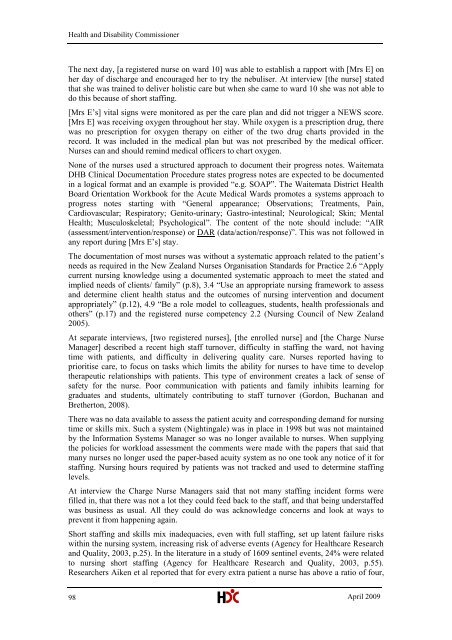North Shore Hospital report - New Zealand Doctor
North Shore Hospital report - New Zealand Doctor
North Shore Hospital report - New Zealand Doctor
Create successful ePaper yourself
Turn your PDF publications into a flip-book with our unique Google optimized e-Paper software.
Health and Disability CommissionerThe next day, [a registered nurse on ward 10] was able to establish a rapport with [Mrs E] onher day of discharge and encouraged her to try the nebuliser. At interview [the nurse] statedthat she was trained to deliver holistic care but when she came to ward 10 she was not able todo this because of short staffing.[Mrs E‘s] vital signs were monitored as per the care plan and did not trigger a NEWS score.[Mrs E] was receiving oxygen throughout her stay. While oxygen is a prescription drug, therewas no prescription for oxygen therapy on either of the two drug charts provided in therecord. It was included in the medical plan but was not prescribed by the medical officer.Nurses can and should remind medical officers to chart oxygen.None of the nurses used a structured approach to document their progress notes. WaitemataDHB Clinical Documentation Procedure states progress notes are expected to be documentedin a logical format and an example is provided ―e.g. SOAP‖. The Waitemata District HealthBoard Orientation Workbook for the Acute Medical Wards promotes a systems approach toprogress notes starting with ―General appearance; Observations; Treatments, Pain,Cardiovascular; Respiratory; Genito-urinary; Gastro-intestinal; Neurological; Skin; MentalHealth; Musculoskeletal; Psychological‖. The content of the note should include: ―AIR(assessment/intervention/response) or DAR (data/action/response)‖. This was not followed inany <strong>report</strong> during [Mrs E‘s] stay.The documentation of most nurses was without a systematic approach related to the patient‘sneeds as required in the <strong>New</strong> <strong>Zealand</strong> Nurses Organisation Standards for Practice 2.6 ―Applycurrent nursing knowledge using a documented systematic approach to meet the stated andimplied needs of clients/ family‖ (p.8), 3.4 ―Use an appropriate nursing framework to assessand determine client health status and the outcomes of nursing intervention and documentappropriately‖ (p.12), 4.9 ―Be a role model to colleagues, students, health professionals andothers‖ (p.17) and the registered nurse competency 2.2 (Nursing Council of <strong>New</strong> <strong>Zealand</strong>2005).At separate interviews, [two registered nurses], [the enrolled nurse] and [the Charge NurseManager] described a recent high staff turnover, difficulty in staffing the ward, not havingtime with patients, and difficulty in delivering quality care. Nurses <strong>report</strong>ed having toprioritise care, to focus on tasks which limits the ability for nurses to have time to developtherapeutic relationships with patients. This type of environment creates a lack of sense ofsafety for the nurse. Poor communication with patients and family inhibits learning forgraduates and students, ultimately contributing to staff turnover (Gordon, Buchanan andBretherton, 2008).There was no data available to assess the patient acuity and corresponding demand for nursingtime or skills mix. Such a system (Nightingale) was in place in 1998 but was not maintainedby the Information Systems Manager so was no longer available to nurses. When supplyingthe policies for workload assessment the comments were made with the papers that said thatmany nurses no longer used the paper-based acuity system as no one took any notice of it forstaffing. Nursing hours required by patients was not tracked and used to determine staffinglevels.At interview the Charge Nurse Managers said that not many staffing incident forms werefilled in, that there was not a lot they could feed back to the staff, and that being understaffedwas business as usual. All they could do was acknowledge concerns and look at ways toprevent it from happening again.Short staffing and skills mix inadequacies, even with full staffing, set up latent failure riskswithin the nursing system, increasing risk of adverse events (Agency for Healthcare Researchand Quality, 2003, p.25). In the literature in a study of 1609 sentinel events, 24% were relatedto nursing short staffing (Agency for Healthcare Research and Quality, 2003, p.55).Researchers Aiken et al <strong>report</strong>ed that for every extra patient a nurse has above a ratio of four,98April 2009
















